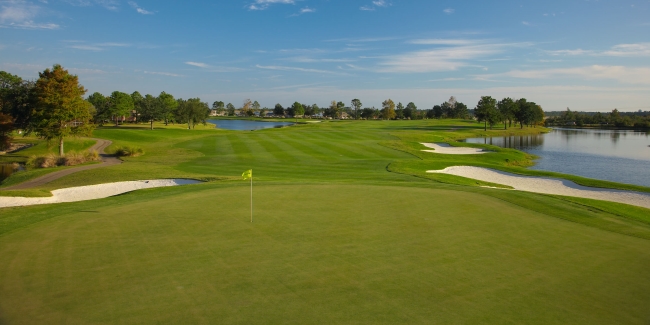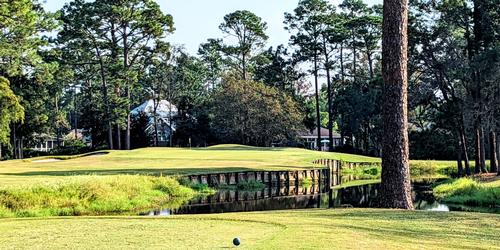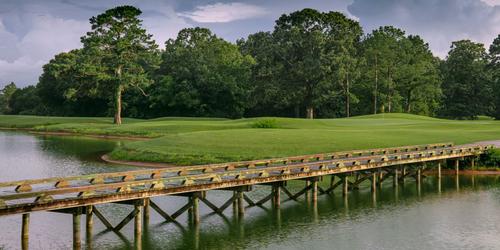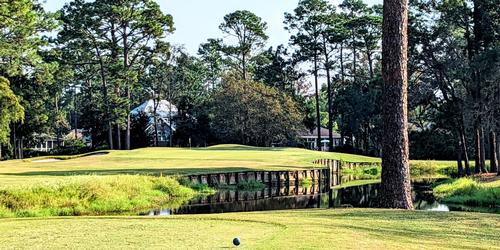
Alabama's Gulf Shores-Orange Beach Golf Guide
The Destination Makes The Grade for Great Golf
By Steve Habel
With a plethora of varied lodging options, restaurants and attractions galore and one of the prettiest, white sands beaches anywhere along the coast of the Gulf of Mexico, the Gulf Shores-Orange Beach-Perdido Key area -set where the southeast edge of Alabama meets the Florida Panhandle - has a little bit of everything.
This sun-splashed region has been a favorite place to get away for decades, with its full-time population of about 30,000 regularly expanding to three times that many folks between Spring Break and Labor Day.
For our purposes, the area became a real place to circle on the map when it built a roster of top-notch golf courses, among them one of the best tracks in all of Alabama.
A recent trip to Gulf Shores-Orange Beach-Perdido Key area showed that the courses here are even better than we remembered on our other two sojourns to this hotbed for fun in the sun. We got a chance to play on five of the destination's courses and are already looking for a spot in our schedule for another visit.
The Grande Dame for golf in the area is the Craft Farms golf resort in Gulf Shores, where two courses designed by Arnold Palmer challenge golfers with their subtle difficulties among the landscape of south Alabama's massive live oaks dripping with Spanish moss, towering pine forests, numerous lakes, creeks and native wildlife. These two public golf courses are the only ones in Alabama designed by Palmer.
Palmer's first course - Cotton Creek - opened for play in 1987 as the first real resort course in this region. Featuring rolling fairways and large undulating greens, Cotton Creek's routing is a true championship test from its back tees (carded at 7,127 yards) while remaining very playable from the forward tees. It was designed by the King to push golfers to play their best rather than intimidate them, with numerous risk-reward opportunities throughout the routing.
The reception for Cotton Creek was so good that Palmer designed another course - Cypress Bend - on the massive property. Cypress Bend has more of a coastal feel as it traverses a unique system of cord-grass accented lakes that bring water into play on almost every hole.
Cypress Bend's fairways are wider that Cotton Creek's, with large landing areas to create confidence off the tee box for all levels of players. The course is also a lot shorter than its big sister, playing at 6,848 yards from the tips.
The ante is upped a bit just down the road toward iconic Fort Morgan at the Peninsula Golf & Racquet Club, a 27-hole championship golf facility that's considered by many to be one of the most memorable and enjoyable courses in the southeast.
Peninsula's golf course was designed by Earl Stone to offer a constantly changing variety of golf and visual appeal that will keep even the most avid golfer challenged and captivated both by its design and surroundings. The facility offers three distinctive nine-hole routings that offer golfers a dramatically different playing experience time after time.
Stone's design here asks golfers to move the ball in both directions, to play over or past tree and/or hazards that are often right in the line of attack and have a steady hand on the approach in order to attack the track's undulating putting surfaces.
Another Stone gem - also 27-holes worth of golf - is Timber Creek Golf Club in Daphne, just a conversation north of the Gulf Shores area. Here the unofficial designer of choice in Alabama's three nines (called Dogwood, Pines and Magnolia) meander through a master planned neighborhood and down tree-lined corridors.
The elevation changes at Timber Creek is more extreme that at any of the courses further south and closer to the coast, the routing is one of the toughest in the area - especially when the winds are up or the course is wet. Picturesque holes punctuate the demand for focus and solid golf throughout the round, but stick to the basics (fairway, green, two putts) to card a low round.
If the above courses were the main course for a great dinner, our final stop in Gulf Shores - the over-the-top great Kiva Dunes - was the piece de resistance.
Kiva Dunes, located on a strip of land bordered by the Gulf of Mexico and Bon Secour Bay, is the state's top-ranked course, according to Golfweek magazine, and it's near the top on almost every other list.
Kiva Dunes was fashioned by Alabama-native Jerry Pate, winner of the 1976 US Open as a PGA Tour rookie, and opened in 1995. Pate designed a wide-open, links-style course that meanders through sand and trees and environmentally protected areas.
It's a course where hitting it straight is imperative, but even more of a challenge when the wind blows at Kiva Dunes, and from which direction. Golfers can play Kiva Dunes on multiple occasions and the course will play radically differently, depending on the wind direction.
This fall, Kiva Dunes unveiled exciting new improvements and renovations that aim to expand the playability of the course by the average high-handicapper while maintaining the challenges and shot-values enjoyed by the most experienced golfers. Pate's work on the renovations has definitely made a positive difference on the course and allows one of the best tracks in Alabama to maintain its lofty ranking.
If there was a surprise course on the trip it was Lost Key Golf Club, set just across the Alabama-Florida border in Perdido Key. Redesigned by the Arnold Palmer Design Group in 2006, the signature championship course features Sea Dwarf Paspalum grass on every playing surface and Palmer's characteristic, distinct bunkering.
Here, the bunkers are both strategic and aesthetic, with sharp, well-defined edges that also blend in with the natural dunes and vegetation. The designers had to take pains to rout Lost Key through the natural wetlands that flow through the property's 150 acres.
They did a god job: Lost Key was the first course in Florida to earn Audubon International's Silver Signature Sanctuary award.
Much was made before our round about Lost Key's difficulty but we found the course to be infinitely playable and in impeccable condition. It's a great mix of long and short holes. Those who can really golf their ball will enjoy Lost Key's many risk/reward opportunities and the average player can be successful on the course if he or she keeps their ball out of the many water hazards and uses proper course management.
Whether it's an annual trip with the guys, a weekend getaway for two or a trip with the entire family, golfers can customize a stay-n-play golf package to Gulf Shores-Orange Beach-Perdido Key that's perfect for their group. Thanks to the work of Palmer, Pate and Stone, the golf here makes the grade.
Revised: 02/01/2016 - Article Viewed 29,901 Times
About: Steve Habel
![]() Steve Habel is a contributing editor for GolfTrips and its associated websites. A 26-year industry veteran, he regularly contributes to various regional, national and international golf publications and has played and written about more than 1,600 golf courses around the world.
Steve Habel is a contributing editor for GolfTrips and its associated websites. A 26-year industry veteran, he regularly contributes to various regional, national and international golf publications and has played and written about more than 1,600 golf courses around the world.
Habel is also senior editor for Horns Illustrated magazine, a publication focusing on University of Texas sports, as well the San Antonio Spurs beat writer for The Sports Xchange. He is a correspondent for the Austin American-Statesman and frequently files stories and features for The Associated Press and Preferred Lifestyle magazine.
Habel, who lives in the Austin, Texas area, has worked media coordinator for World Golf Hall of Fame player and golf architect Tom Kite as well as for renowned golf architects Roy Bechtol and Jeffrey D. Brauer.
He is a member of the Golf Writers Association of America, the Texas Golf Writers Association and the Football Writers Association of America.












